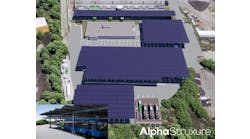In this week’s Industry Perspectives, Dynapower’s Chip Palombini shares how DC-coupled solar plus storage microgrids can help maximize energy potential and cut down on installation costs.
Chip Palombini, sales manager, Dynapower Energy Storage Group
As utilities improve grid resiliency through the use of non-transmission alternatives, solar plus storage microgrids have gained traction for their ability to provide valuable energy in times of peak demand. They also serve as a means for utilities to stave off costly wired infrastructure investments. Nearly half of all microgrids today involve energy storage, according to a 2016 Greentech Media report.
The number of microgrids utilizing energy storage will see a significantly improved performance boost of up to 35 percent by coupling solar with energy storage to the DC PV bus. Using a DC-to-DC converter to couple solar and storage reduces levelized costs of energy as well as increases solar energy production — making solar plus storage even more attractive for utilities, municipalities, and private enterprise.
Dynapower installed its first DC-to-DC converter for solar plus storage in the microgrid at Over Yonder Cay Resort in the Bahamas in 2015. Since then we have built upon that experience and our work in delivering power electronics and controls to numerous microgrids worldwide to recently introduce to the market a commercial 250 kW DC-to-DC converter, the first of which are being installed with utilities in North Carolina and Florida, as well as at a resort in Guatemala.By coupling energy storage to the PV DC bus with a DC-to-DC converter, equipment and installation costs can be reduced, when compared to AC coupled solar plus storage systems.
By coupling energy storage to the PV DC bus with a DC-to-DC converter, equipment and installation costs can be reduced, when compared to AC coupled solar plus storage systems. In contrast to centralized, AC-coupled storage, DC-coupled storage eliminates the need for AC switchgear or a substation interconnection and reduces site work.
A DC-coupled solar plus storage microgrid optimizes the array as well. For microgrids utilizing energy storage, the DC-coupled approach holds the highest efficiency of the system topologies for coupling energy storage with solar when compared to AC-coupled or hybrid options. The efficiency achieved via DC-coupled storage stems from the avoidance of funneling power through two MV transformers in the charging process as is required by AC-coupled energy storage systems.
[clickToTweet tweet=”Chip Palombini – Using a DC-to-DC converter to couple solar and storage reduces levelized cost of energy. ” quote=”Chip Palombini – Using a DC-to-DC converter to couple solar and storage reduces levelized cost of energy. “]
Additionally, DC-coupling solar and storage enables an installation to capture energy earlier and later in the day, given that central PV inverters typically require a minimum threshold DC bus voltage to operate. On a 1,500 VDC nominal system, this ‘wake up’ voltage may commonly be around 800 VDC, below which the system is not harvesting available PV production. This period of time at end of day or beginning of day when the array has potential, but the inverter is not awake, can be over 30 minutes on each end.
Clipped energy recapture remains the most significant advantage of coupling energy storage to a solar microgrid. Given common inverter loading ratios of 1.25 up to 1.5 on utility-scale PV, there is opportunity for the recapture of clipped energy through the addition of storage on the DC bus. Using a simplified system for illustrative purposes, consider a 14 MWDC PV array behind a total inverter capacity of 10 MWAC. Depending on your location and type of racking, the total clipped energy can be over 1,000,000 kWh per year. Without energy storage these kilowatt-hours are lost and energy generation stunted.
Of additional benefit to the microgrid, when storage is on the DC bus behind the PV inverter, the energy storage system can operate and maintain the DC bus voltage when the PV inverter is off-line for scheduled or unplanned outages. Additionally, when the PV inverter is offline the energy from the array can still flow to the batteries via the DC-DC converter ensuring energy can be harvested for use by the microgrid.
With the decrease in installation costs, higher efficiency, and the ability to capture more energy through the PV array, we at Dynapower feel a DC-coupled approach makes the case compelling for new solar plus storage microgrids, as well as adding energy storage to existing solar microgrids — a potential boon to microgrid installations worldwide.
Chip Palombini is the sales manager for the Dynapower Energy Storage Group.





